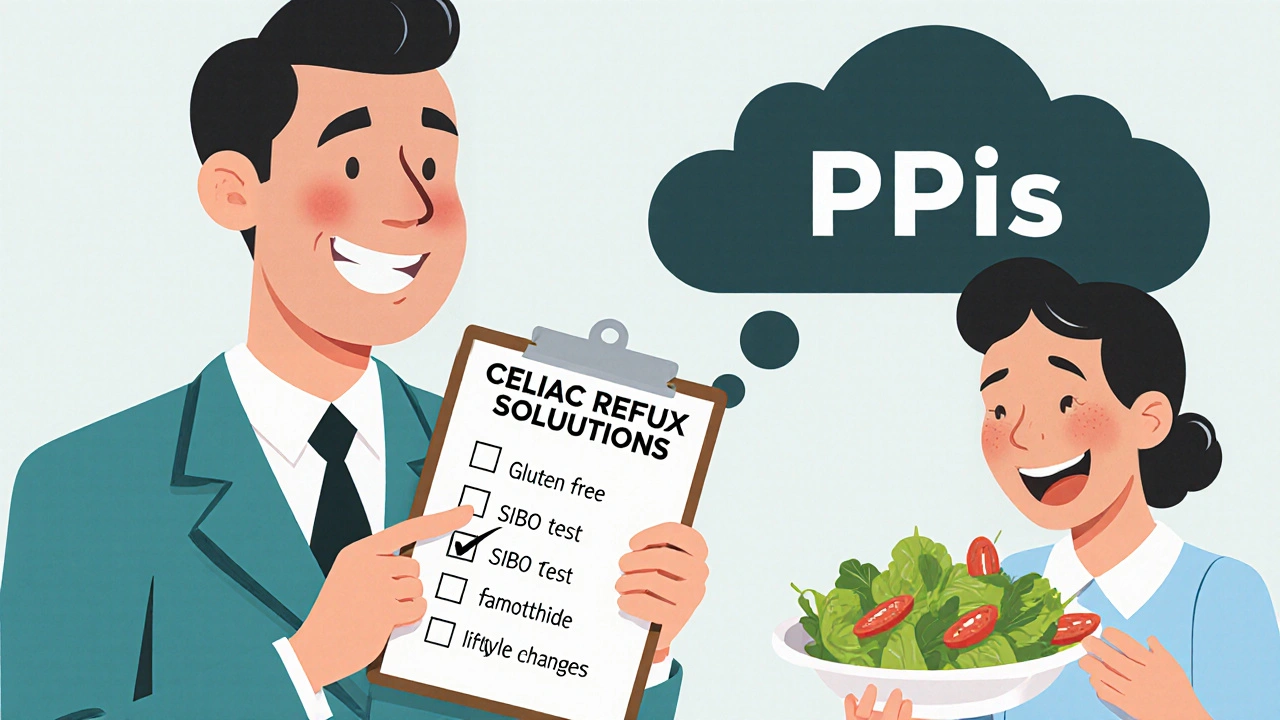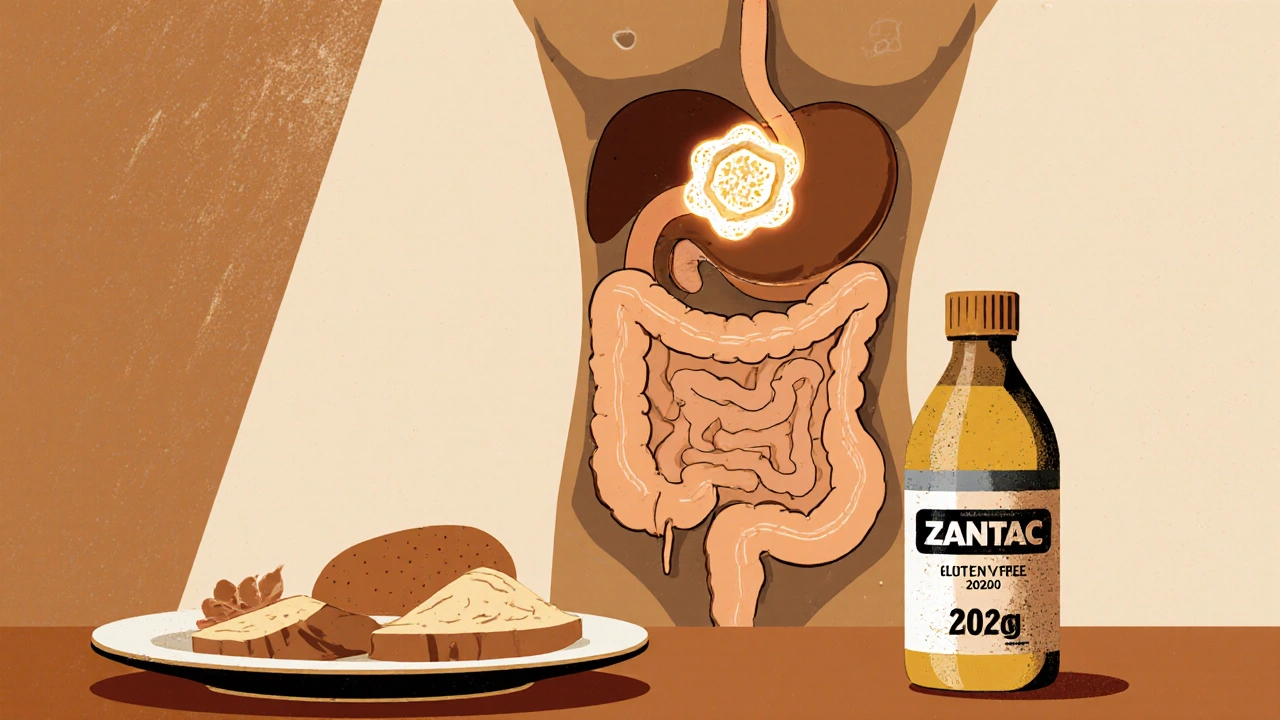If you have celiac disease and struggle with persistent heartburn or stomach acid, you might have wondered: could ranitidine help? It’s a question that pops up often in online forums and doctor’s offices. After all, many people with celiac disease report acid reflux, bloating, and nausea-even when strictly gluten-free. But ranitidine isn’t a cure for celiac disease, and it’s not even available anymore in most places. Here’s what you actually need to know.
What happened to ranitidine?
Ranitidine, sold under the brand name Zantac, was once one of the most common drugs for heartburn and acid reflux. It worked by blocking histamine receptors in the stomach, reducing acid production. Millions used it daily. But in 2020, the FDA issued a full recall after testing found NDMA, a probable human carcinogen, in many batches. The drug was pulled from shelves in the U.S., Canada, the EU, and Australia. Today, you can’t legally buy ranitidine over the counter or by prescription in most countries.
That doesn’t mean the question goes away. People with celiac disease still need relief from acid-related symptoms. So if ranitidine is gone, what’s left? And more importantly, does acid reflux in celiac disease even need the same treatment as in people without it?
Why do people with celiac disease get acid reflux?
It’s not just bad luck. Celiac disease damages the small intestine, which can mess with digestion in ways that trigger reflux. When the gut lining is inflamed, food moves slower. The stomach may produce more acid trying to break down poorly digested food. Some people also develop small intestinal bacterial overgrowth (SIBO), which causes gas, bloating, and pressure that pushes acid upward.
Studies show that up to 60% of newly diagnosed celiac patients report heartburn or GERD-like symptoms. After going gluten-free, most see improvement within weeks. But for some, symptoms linger. That’s when people reach for antacids or acid blockers-like ranitidine used to be.
Does ranitidine actually help celiac symptoms?
Ranitidine doesn’t treat the root cause of celiac disease: gluten exposure. It only masks the acid. If your heartburn is from gluten contamination, ranitidine won’t stop the immune reaction. It might make you feel better for a few hours, but the damage to your gut continues.
There’s no clinical evidence that ranitidine improves intestinal healing in celiac disease. One 2018 study in the Journal of Pediatric Gastroenterology and Nutrition looked at 87 children with celiac disease and persistent reflux. After switching to a strict gluten-free diet, 82% saw complete resolution of reflux symptoms. Only 5% needed ongoing acid suppression-none needed ranitidine.
Bottom line: ranitidine might temporarily reduce discomfort, but it doesn’t fix the problem. And now that it’s banned, you don’t have the option anyway.

What can you use instead of ranitidine?
Several safe, effective alternatives exist. The most common are:
- Proton pump inhibitors (PPIs) like omeprazole, esomeprazole, or pantoprazole. These reduce acid more effectively than old H2 blockers. But long-term use can interfere with nutrient absorption-something celiac patients already struggle with.
- H2 blockers like famotidine (Pepcid) or nizatidine. These are still available and work similarly to ranitidine but without the NDMA risk. Famotidine is often the first choice for celiac patients needing acid control.
- Antacids like calcium carbonate (Tums) or magnesium hydroxide (Milk of Magnesia). These offer quick, short-term relief and are safe for occasional use.
Many doctors now recommend starting with lifestyle changes before reaching for medication:
- Eat smaller, more frequent meals
- Avoid lying down for at least 3 hours after eating
- Limit caffeine, alcohol, spicy foods, and fatty meals
- Check for hidden gluten in sauces, seasonings, and processed foods
- Test for SIBO or lactose intolerance-both common in celiac disease and can mimic reflux
When should you see a doctor?
If you’re still having acid reflux after 3-6 months on a strict gluten-free diet, it’s time to dig deeper. Your doctor should check for:
- Continued gluten exposure (even tiny amounts from cross-contamination)
- SIBO (via breath test)
- Helicobacter pylori infection
- Esophagitis or Barrett’s esophagus
- Other food intolerances (like FODMAPs)
Don’t assume your reflux is just "part of celiac." Persistent symptoms could signal something else-something that needs targeted treatment.
Can acid blockers harm celiac patients?
Yes, they can. Long-term use of PPIs and even H2 blockers can reduce stomach acid too much. That sounds good for heartburn, but low acid means:
- Poor absorption of iron, calcium, magnesium, and B12-all nutrients celiac patients are already at risk for
- Increased risk of gut infections, including C. diff
- Worsened SIBO because stomach acid normally kills harmful bacteria
A 2021 study in Gastroenterology found that celiac patients on long-term PPIs had 2.3 times higher rates of nutrient deficiencies than those not on acid blockers. The same risk applies to famotidine, though less severely.
That’s why experts recommend using acid-reducing meds only when necessary-and for the shortest time possible.
Real-world example: Sarah’s story
Sarah, 34, was diagnosed with celiac disease in 2022. She followed a strict gluten-free diet but still had daily heartburn. She tried ranitidine before it was pulled, then switched to omeprazole. After six months, she felt worse-fatigued, bloated, and anemic. Her doctor ordered a SIBO breath test. It came back positive. She treated it with antibiotics and a low-FODMAP diet. Within eight weeks, her reflux disappeared. She stopped the PPI and hasn’t needed it since.
Her story isn’t rare. Medication isn’t always the answer. Sometimes, the real problem is hiding in plain sight.
What to do today
If you have celiac disease and heartburn:
- Double-check your gluten-free diet. Even trace gluten can trigger inflammation and reflux.
- Keep a food and symptom diary. Note timing, meals, and acid reflux episodes.
- Try famotidine (Pepcid) for short-term relief if needed. Avoid PPIs unless your doctor says it’s necessary.
- Ask your doctor about testing for SIBO, H. pylori, or other causes.
- Focus on healing your gut-not just suppressing acid.
There’s no magic pill for celiac-related reflux. But there are better, safer ways to get relief-and to heal your body from the inside out.
Is ranitidine still available for celiac disease?
No. Ranitidine (Zantac) was recalled worldwide in 2020 due to contamination with NDMA, a probable carcinogen. It is no longer sold legally in the U.S., Canada, the EU, or Australia. Even if you find it online, it’s unsafe and not recommended.
Can famotidine replace ranitidine for celiac-related reflux?
Yes. Famotidine (Pepcid) is a safe and effective H2 blocker that works similarly to ranitidine but without the cancer risk. It’s often the first choice for short-term acid relief in celiac patients. However, it should only be used temporarily and under medical supervision.
Why does acid reflux persist even after going gluten-free?
Even on a gluten-free diet, other factors can cause reflux: SIBO, lactose intolerance, low stomach acid from long-term PPI use, or continued hidden gluten exposure. Inflammation from past damage can also linger. A gluten-free diet heals the gut-but it doesn’t automatically fix all digestive issues.
Are proton pump inhibitors safe for long-term use in celiac disease?
Not ideally. Long-term PPI use can worsen nutrient deficiencies (iron, B12, calcium), increase infection risk, and contribute to SIBO-all problems celiac patients already face. Use PPIs only if absolutely necessary and for the shortest time possible, under a doctor’s guidance.
Should I take antacids like Tums for occasional heartburn with celiac disease?
Yes, antacids like Tums (calcium carbonate) are generally safe for occasional use. They neutralize acid quickly and don’t interfere with gut healing. Just make sure the product is certified gluten-free, as some antacids contain hidden gluten or fillers.


Write a comment